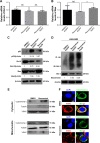Resveratrol induces apoptosis in human melanoma cell through negatively regulating Erk/PKM2/Bcl-2 axis
- PMID: 30588012
- PMCID: PMC6294058
- DOI: 10.2147/OTT.S186247
Resveratrol induces apoptosis in human melanoma cell through negatively regulating Erk/PKM2/Bcl-2 axis
Abstract
Background: Resveratrol is known as a natural phytoalexin found in grapes and wine, which has significant antitumor activity under in vitro and in vivo conditions. In recent years, great progress has been made in understanding the underlying mechanisms of resveratrol in inducing cellular apoptosis of melanoma cells. Our previous study has shown that the apoptosis regulation of resveratrol in melanoma cells was independent of activation of classical apoptosis-related protein p53.
Materials and methods: MTT assay and 5-bromo-2'-deoxyuridine staining assay were used to analyze cell viability and proliferation. Immunofluorescence analysis of γ-H2AX was employed to clarify DNA damages. Annexin V-propidine iodide/fluorescein isothiocyanate assay was performed to evaluate the cell apoptosis. The mechanisms underlying the activation of M2-type pyruvate kinase (PKM2) by Erk1/2 to stabilize and maintain Bcl-2 signaling was investigated by subcellular fractionation analyses, immunofluorescence analysis, co-immunoprecipitation assay, ubiquitination assay, and glutathione S-transferase pull-down assay.
Results: In the present study, we found that resveratrol dramatically inhibited melanoma cell proliferation and induced cell apoptosis through upregulation of p53 in a concentration-dependent manner. Conversely, p53 downregulation by short hairpin RNA couldn't rescue resveratrol-induced cell proliferation inhibition or apoptosis enlargement. Additionally, we found that resveratrol downregulated antiapoptotic protein Bcl-2 and activated Bax in the protein levels by promoting Bcl-2 degradation and cytochrome c release. Moreover, we discovered that PKM2, had a key role in cell apoptosis triggered by resveratrol through interacting with Bcl-2. Based on these results, we overexpressed PKM2 in melanoma cells and found that this prevented resveratrol-induced apoptosis by stabilizing the protein level of Bcl-2.
Conclusion: Taken together, our results provided a novel mechanism accounting for the apoptosis induction of resveratrol in melanoma cells and suggested that downregulating Erk/PKM2/Bcl-2 axis appears to be a new approach for the prevention or treatment of melanoma.
Keywords: ER stress; antitumor; cytochrome c; ubiquitination.
Conflict of interest statement
Disclosure The authors report no conflicts of interest in this work.
Figures

Similar articles
-
Resveratrol Induces Cancer Cell Apoptosis through MiR-326/PKM2-Mediated ER Stress and Mitochondrial Fission.J Agric Food Chem. 2016 Dec 14;64(49):9356-9367. doi: 10.1021/acs.jafc.6b04549. Epub 2016 Dec 5. J Agric Food Chem. 2016. PMID: 27960279
-
Imatinib enhances human melanoma cell susceptibility to TRAIL-induced cell death: Relationship to Bcl-2 family and caspase activation.Oncogene. 2006 Dec 7;25(58):7618-34. doi: 10.1038/sj.onc.1209738. Epub 2006 Sep 18. Oncogene. 2006. PMID: 16983347
-
Resveratrol as a novel agent for treatment of multiple myeloma with matrix metalloproteinase inhibitory activity.Acta Pharmacol Sin. 2006 Nov;27(11):1447-52. doi: 10.1111/j.1745-7254.2006.00343.x. Acta Pharmacol Sin. 2006. PMID: 17049120
-
Diallyl trisulphide-induced apoptosis in human melanoma cells involves downregulation of Bcl-2 and Bcl-xL expression and activation of caspases.Clin Exp Dermatol. 2009 Dec;34(8):e537-43. doi: 10.1111/j.1365-2230.2009.03594.x. Clin Exp Dermatol. 2009. PMID: 20055834
-
Resveratrol modifies the expression of apoptotic regulatory proteins and sensitizes non-Hodgkin's lymphoma and multiple myeloma cell lines to paclitaxel-induced apoptosis.Mol Cancer Ther. 2004 Jan;3(1):71-84. Mol Cancer Ther. 2004. PMID: 14749477
Cited by 5 articles
-
Metformin revert insulin-induced oxaliplatin resistance by activating mitochondrial apoptosis pathway in human colon cancer HCT116 cells.Cancer Med. 2020 Jun;9(11):3875-3884. doi: 10.1002/cam4.3029. Epub 2020 Apr 5. Cancer Med. 2020. PMID: 32248666 Free PMC article.
-
Experimental Study of Hepatocellular Carcinoma Treatment by Shikonin Through Regulating PKM2.J Hepatocell Carcinoma. 2020 Feb 18;7:19-31. doi: 10.2147/JHC.S237614. eCollection 2020. J Hepatocell Carcinoma. 2020. PMID: 32110554 Free PMC article.
-
Development of Drug Dual-Carriers Delivery System with Mitochondria-Targeted and pH/Heat Responsive Capacity for Synergistic Photothermal-Chemotherapy of Ovarian Cancer.Int J Nanomedicine. 2020 Jan 16;15:301-313. doi: 10.2147/IJN.S226517. eCollection 2020. Int J Nanomedicine. 2020. PMID: 32021181 Free PMC article.
-
Simvastatin re-sensitizes hepatocellular carcinoma cells to sorafenib by inhibiting HIF-1α/PPAR-γ/PKM2-mediated glycolysis.J Exp Clin Cancer Res. 2020 Jan 30;39(1):24. doi: 10.1186/s13046-020-1528-x. J Exp Clin Cancer Res. 2020. PMID: 32000827 Free PMC article.
-
Glut 1 in Cancer Cells and the Inhibitory Action of Resveratrol as A Potential Therapeutic Strategy.Int J Mol Sci. 2019 Jul 9;20(13):3374. doi: 10.3390/ijms20133374. Int J Mol Sci. 2019. PMID: 31324056 Free PMC article. Review.
References
-
- Rastrelli M, Tropea S, Rossi CR, Alaibac M. Melanoma: epidemiology, risk factors, pathogenesis, diagnosis and classification. In Vivo. 2014;28(6):1005–1011. - PubMed
-
- Vijuk G, Coates AS. Survival of patients with visceral metastatic melanoma from an occult primary lesion: a retrospective matched cohort study. Ann Oncol. 1998;9(4):419–422. - PubMed
-
- Neila J, Soyer HP. Key points in dermoscopy for diagnosis of melanomas, including difficult to diagnose melanomas, on the trunk and extremities. J Dermatol. 2011;38(1):3–9. - PubMed
-
- Veierød MB, Weiderpass E, Thörn M, et al. A prospective study of pigmentation, sun exposure, and risk of cutaneous malignant melanoma in women. J Natl Cancer Inst. 2003;95(20):1530–1538. - PubMed
LinkOut - more resources
-
Full Text Sources
-
Medical
-
Research Materials
-
Miscellaneous
